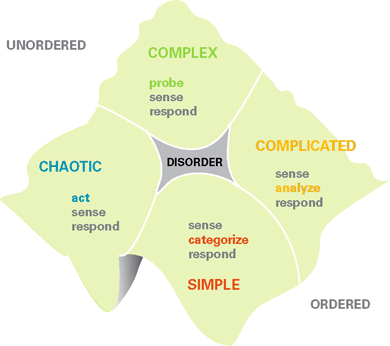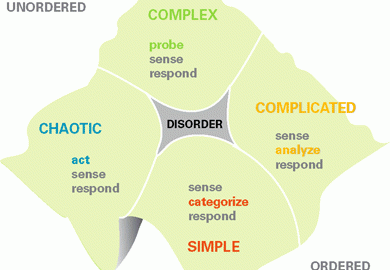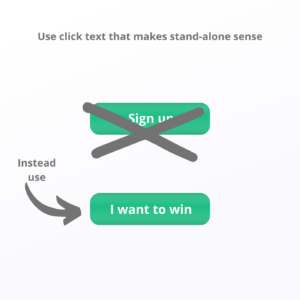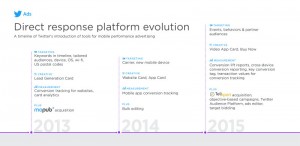— June 4, 2019
Preface: This is the third article in my series on sensemaking, for links to all the others in this series, please go to: Sensemaking, The Big Issue Facing Both Our Customers And Us.
It turns out that sensemaking is not just a “cool buzzword,” that we can apply to helping our customers solve problems, dealing with complexity, or anything else. There’s actually been a lot of study and rigor around the concepts of sensemaking and some models that allow us to apply sensemaking in a rigorous and structured manner.
Over the past year, I’ve studied a lot of these models. I’ll provide you references to some that may be useful to consider in your own sensemaking pursuits. But a model that I’ve found very useful in working with clients, and which seems to be a good extension of much or what we already to in complex B2B selling is the Cynefin Model. It was developed by David Snowden, founder of Cognitive-Edge. A great introduction to these concepts is in the HBR Aricle: A Leader’s Framework For Decision Making
The Cynefin framework provides us models to understand both what our own organizations face and what our customers face. It allows us to categorize and position where we or our customers are, and how to best act, given where we are. A representation of this framework is below:

Courtesy HBR, November 2007 Issue
I will be doing deep dives into each of the quadrants and what they mean from a sales point of view, and how we best engage our customers depending on the quadrant they find themselves. But a quick summary from the HBR article:
- The “Simple Quadrant (or Context) are those where the work can be clearly characterized. The cause-effect relationships are well known to everyone involved (whether we are in the organization, customers to the organizations, or sellers). There is, generally, a set of “right answers,” or best practices. Generally, we see these in very structured process based organizations. For example, many manufacturing processes, financial services, order management and processes might fit into this category. It should be noted that “simple” doesn’t mean easy. These may be very hard or very difficult, but they are well characterized, well understood, and we know the right answers for dealing with problems that occur.
- Complicated Contexts are, well, more complicated. In complicated contexts, there is no single right answer, but there can be multiple ways of solving problems, but there is always at least one right answer. There are clear relationships between cause and effect, but they may not be obvious to everyone involved. In dealing with the complicated quadrant, we will want to assess several alternatives, choosing the one we feel best for the specific situation.
- Complex Contexts are those in which we can’t determine the right answers. We may struggle to characterize the situation or problems, but typically are face with unknowns, ambiguity, constant change. All of these inhibit our ability to understand the situation and the best course forward. As a result, in this domain, we tend to experiment, discovering what works, moving forward as answers or approaches begin to appear. We start to see patterns that emerge and we act on those patterns. At the enterprise level, most organizations are in the complex domain. As we reflect on the pace of change, disruption, turbulence organizations face, we’ve never encountered them before, so we struggle with determining the path forward.
- The Chaotic domain is characterized by shifts and change that are so dramatic and so fast that it’s impossible to determine the cause effect relationships or to discern patterns–because none exist. In these situations, it’s incumbent for leaders to act fast. They aren’t looking necessarily to solve the problem but rather to “stop the bleeding.” The concept of “triage” is important in this domain and leaders seek only to triage the situation, enabling movement into another domain. From a sales point of view, we are rarely involve in addressing these situations. Intuitively, we can see this because our companies are the best at solving certain problems. In the chaotic domain, we can’t identify the problems, so as sales people we can’t add much value. But because we can define problems in each of the other quadrants, the opportunities for us to create great value are tremendous. (As a sidenote, if you are a consultant, you may find this domain very rich in opportunity. Much of our work in doing turnarounds is with companies in this domain, and we need to move them out of it as quickly as possible.)
This model is very powerful in understanding where our customers are at, and how we might best help them address their challenges. As you see in the diagram, there are differing courses of action in each quadrant.
- For the simple, they are: sense, categorize, respond.
- For the complicated they are: sense, analyze, respond.
- For the complex, they are: probe, sense, respond.
- For the chaotic, they are: act, sense, respond.
This model helps us better understand what sensemaking is and how we can help our customers “sense, categorize, respond, analyze, and probe” appropriately.
A couple of final notes:
- The quadrant our customers are in may be different from the quadrant their company is in. For example, while the enterprise may be in the Complex Quadrant, if our customers are in accounts receivable/payable, they may be in a Simple or Complicated Quadrant.
- It’s important for us to understand where our customers are, then leverage the model for how we best engage them in solving their problems.
- Our customers may not understand which quadrant they operate in, or have a model for dealing with where they are. We can create great value to help them develop models for the quadrant they are in.
- We will find, that we may choose to intercept the customer in a different quadrant than we currently work with them. This can be very powerful in strategically repositioning who we engage, how we engage them, and how we create value.
- Our own organizations–both the sales organization and our companies are in one or more of these quadrants, so as we look to understand our own strategies and performance, this approach provides us some methods for moving forward.
I will go into these in much greater depth in the next several posts.
Business & Finance Articles on Business 2 Community
(129)
Report Post







